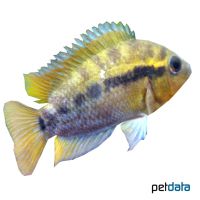Rainbow Cichlid (Herotilapia multispinosa)
| Rainbow Cichlid Herotilapia multispinosa | |
|---|---|
| Name | Rainbow Cichlid |
| Name Lat. | Herotilapia multispinosa |
| Synonym | Archocentrus multispinosus |
| Family | Cichlids |
| Family lat. | Cichlidae |
| Order | Cichlids |
| Order lat. | Cichliformes |
| Origin | Central America |
| Habitat | Lakes, swamps |
| Diet | Omnivore |
| pH | 7.0-8.0 |
| Behavior | Peaceful |
| Keeping | Pair |
| Care Level | Moderate |
| Reproduction | Substrate spawner |
| Breeding | Moderately difficult |
| Life Span | 3-5 years |
| Protection | No |
| Metric Units | |
| Size | 10-12 cm |
| Temperature | 22-28 °C |
| Hardness | < 20 °dH |
| Aquarium | ~ 250 l |
| US Units | |
| Size | 4"-5" |
| Temperature | 72-82 °F |
| Hardness | < 356 ppm |
| Aquarium | ~ 60 gal |
Distribution and habitat
The range of the rainbow cichlids extends from Guatemala through Honduras and Nicaragua to Costa Rica, where they are found in rivers flowing to the Atlantic Ocean. They live in the moderately flowing waters, lakes, ponds and floodplains with muddy bottoms and numerous hiding places, such as roots, branches and dead wood.
Maintenance
The aquarium should have dense planting that provides both shelter and swimming space, with plenty of roots and rocks for hiding. A dark sandy substrate covered with some foliage and slightly dim light (floating plants) is ideal.
No ammonia, ammonium and nitrite should be detectable, the nitrate value should not exceed 100 mg/l. To ensure the water quality and oxygen content, a filter and heater adapted to the aquarium size is required, as well as lighting for the species-appropriate day-night rhythm of the animals.
Diet
In nature they feed mainly on detritus and plant food. The diet consists of high quality sinking dry food for cichlids (pellets, granules) with high vegetable content (spirulina) and algae leaves, supplemented with some live or frozen food, such as artemia, mysis, tubifex and red mosquito larvae or a commercially available frozen special food mix for cichlids.
Only feed as much as is eaten immediately (in a maximum of 10 minutes). Regular and varied feeding promotes health and increases resistance.
Behaviour and compatibility
These calm and relatively peaceful fish should be kept in pairs. During the spawning season they behave territorially and defend their territory emphatically. Keeping multiple pairs is only recommended in larger, richly structured tanks. They can be socialized well with peaceful fish like barbs, characins and catfishes. However, fish that are too small are considered prey. Basically, only compatible fish species with similar demands on water condition and water temperature should be socialized.
Sex dimorphism
The sexes are difficult to distinguish. The larger males have extended dorsal and anal fins. With some experience, the sexes can be distinguished by their genital papilla, which is pointed in the male and round in the female.
Reproduction and breeding
They spawn on shallow stones or roots (open brooders). Both parents perform brood care and defend the territory (parental family). After about 2 days, the fry hatch and are then usually housed in a prepared bottom pit until they swim freely after 5-7 days. Often the fry are moved several times to other bottom pits before brood care ends.
Fry must be fed several times a day with special rearing food (Artemia nauplii). In community tanks breeding is hardly possible, because the fry are easy prey.
Important
According to their mood, they can quickly change their coloring
They hardly dig and plants are not damaged.
The well-being of the fish should be checked regularly. Temperature should be checked daily, pH, hardness and nitrate value at least every 14 days. A regular partial water change is recommended, even if the pollutant load has not yet reached the upper limit. Sudden changes in water quality should be avoided. Newly introduced fish must be accustomed slowly to the water in the aquarium.
Further literature can be found in your pet store.
References
Text: petdata; Image: petdata
Source: BMELV (1998): Tierschutzgutachten - Haltung von Zierfischen (Süßwasser); RIEHL & BAENSCH (2006): Aquarien Atlas Bd. 1, Mergus Verlag; ENGELMANN (2005): Zootierhaltung - Tiere in menschlicher Obhut: Fische, Verlag Harri Deutsch
- Gemäß § 21 Abs. 5 Tierschutzgesetz idgF
